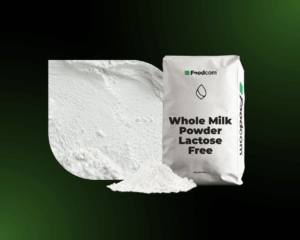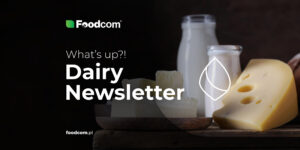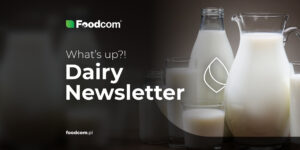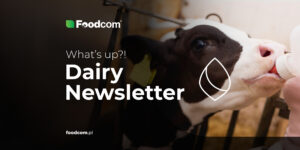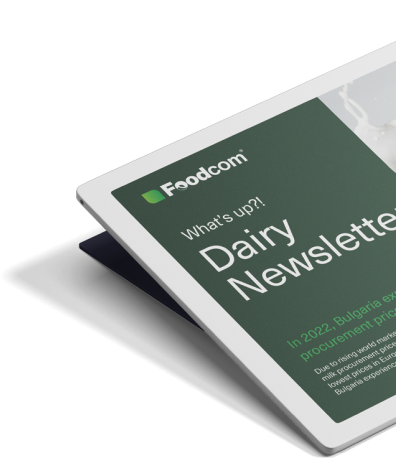- Global trade is entering a phase where stability is becoming a luxury.
- The milk powder market is struggling with oversupply and falling prices, and producers are fighting to maintain liquidity.
- European cheeses are becoming cheaper, while America is gradually regaining the balance between supply and demand.
- The fats and liquids market is cooling down after a hot summer, and buyers are playing it increasingly safe.
- The EU is opening up to Ukraine, Ireland is playing the genetics card, and New Zealand is testing a new climate model – the world of milk is changing the rules of the game.
Welcome Partners!
Welcome back to our newsletter!
The global dairy sector starts the fourth quarter highly contrasted. The European Union is opening up to Ukrainian trade, which could shatter the existing balance of power in the agricultural commodities market. Ireland bets on genetics and embryo exports, consolidating its position at the top of the EU. New Zealand is abandoning its methane tax, shifting responsibility for reducing emissions to the processing industry. In the background, a common denominator can be seen – the search for a balance between efficiency and ecology which is increasingly shaping the prices and directions of the global milk trade.
Scroll down for detailed market data and forecasts.
Milk powder
The skimmed milk powder(SMP) market in Europe enters the fourth quarter amid a persistent oversupply. Prices remain in the €2,100-2,150/MT range, with high production volumes and slowing exports limiting the potential for growth. Producers are shortening contracts and increasingly introducing more flexible commercial terms to increase stock turnover as well as maintain sales liquidity.
In Oceania, the high supply associated with the peak season is keeping skimmed milk powder (SMP) prices in the region of EUR 2 220/MT. Most of the supply is going to Asian markets, but import levels are not offsetting the increased production. In the Americas, the situation remains mixed, with SMP costing around EUR 2 160/MT in the US and EUR 2 495/MT in Latin America, reflecting cost and logistical differences between the regions.
Whole milk powder (FCMP) continues its downward trend. In Europe, prices are in the range of EUR 3 600-3 750/MT, while in Oceania they are around EUR 3 190/MT. Despite greater buying activity in Asia, the market remains burdened by high production and significant stocks. The last quarter of the year is marked by strong price competition, as well as efforts to reduce surpluses before the start of the new season.
Cheese
The European cheese market ended the week under clear downward pressure. Surplus milk and lower buyer activity reduced prices for all major grades. Gouda is trading in the region of €3,100/MT and mozzarella is holding slightly lower, at €3,050/MT. Cheddar is also losing ground, reaching an average of EUR 3,700/MT. High stocks and limited exports are prompting processors to plan their sales cautiously and shorten contracts to be able to react more quickly to changes in demand.
In Oceania, the situation is more stable. Cheddar is priced at almost €4200/MT and the balance in the market is helped by steady demand from Asia. Good weather conditions are favourable for production, but producers remain disciplined in their inventory management and apply a moderate pricing policy. Competition from Europe continues to be felt, limiting growth potential despite improving export conditions.
The Americas are seeing a slight firming of prices. In the United States, mozzarella is rising in price, reaching around €3,350-3,400/MT, driven by rising domestic demand and a good business climate in the catering industry. In Latin America, gouda is additionally on the rise, with quotes rising to almost EUR 4,000/MT, supported by greater export activity and a stable local market. Although the improvement is moderate, the direction of change indicates a slow rebalancing of the relationship between supply and demand after several weeks of declines.
Fats
After a dynamic summer, the market for dairy fats in Europe is entering a phase of marked cooling. Butter prices are in the range of EUR 5,300-5,400/MT, while anhydrous milk fat(AMF) is reaching around EUR 6,400/MT. Continued surpluses of raw material and limited exports are preventing a rebound, with producers focusing on controlling supply and short-term sales. Rising financing costs and economic uncertainty are further dampening purchasing activity in the domestic market.
In Oceania, prices remain relatively higher, with butter priced at €5 700-5800/MT and anhydrous milkfat at €6 000-6 100/MT. High peak supply and moderate demand from Asia are keeping the market in balance, but space for further increases is limited. Exporters are focusing on maintaining margins and flexibly adjusting volumes to avoid inventory pressure at the end of the year.
In the Americas, prices remain lower than in the rest of the region, reflecting both cost differences and a structural surplus of raw material. In the US, butter is in the €3,300-3,600/MT range and anhydrous milkfat remains around €4,300 – €4,400/MT. Demand remains conservative and trading concentrated on short contracts. Looking ahead to the coming months, the market is expected to stabilise with a reduction in milk supply and a gradual recovery in export demand.
Liquids
The European liquid dairy market is seeing increasing price stratification. Cream quotations are in the €6000-6200/MT range, with slight increases in most Western European countries and decreases in the UK and Eastern Europe. The market is balancing between increasing milk supply and limited processing capacity, leading to uncertainty among processors. It is becoming increasingly clear that maintaining high prices in this segment is becoming increasingly difficult.
The situation for concentrated skimmed milk(SMC) is much more dynamic. Prices in Europe have fallen sharply – by up to 15% depending on the region, now reaching levels of EUR 1350-1450/MT. Such a large shift is the result of growing stocks and insufficient demand, which is unable to absorb surplus raw material. Processors are reducing purchases and some contracts are being postponed to later months in anticipation of market stabilisation.
On the other side of the Atlantic, the mood is more subdued. In the US, cream is mainly traded under long-term contracts and spot market activity remains low. Prices remain close to last week’s levels, but there are growing concerns that high stocks of milk fat could soon trigger a similar corrective move to that in Europe.
Whey powder
The European whey market is seeing a slight rebound in prices. Food grade whey(SWP) is quoted in the range of EUR 950-1070/MT and feed whey as EUR 920-970/MT. Changes from the previous week are moderate, but indicate improved export activity and lower availability of raw material. In the US, whey quotations are declining, with trade focusing on long-term contracts. Oversupply and weak exports continue to affect prices.
In the whey protein segment, prices are rising moderately, maintaining a stable upward trend. Whey protein concentrate(WPC80) in Europe is quoted at around EUR 12,000/MT and isolate(WPI) reaches EUR 19,800 – 20,000/MT. The increases are being driven by growing demand from functional food or supplement manufacturers. In the US, the scale of the increases is slightly larger. Buyers are securing supply for the next quarters, which reduces current supply and stabilises prices.
Whey permeate in Europe is maintaining the previous week’s price, while in the USA it is recording further declines, as is lactose. Continued high stocks limit the potential for price increases and demand in both markets remains moderate. Most customers have already secured supplies, so trading activity has clearly dimmed, with new deals only occurring at more competitive price offers.
What’s new?
European Union
The European Union has taken another step towards economic integration with Ukraine. Member states have formally approved a new trade agreement that opens the door to a wider exchange of agricultural goods and closer economic cooperation. For Ukraine, this is an opportunity for a stronger entry into European markets, and for the EU, a test of the balance between solidarity and protection of its own producers. The agreement provides for the gradual dismantling of tariffs and the alignment of Ukrainian standards with those of the EU, as well as mechanisms to maintain market stability during periods of increased inflows. For the dairy sector, this offers both the prospect of new export opportunities and the real risk of stronger competition from Ukrainian producers.
Ireland
In Ireland, cattle breeders are increasingly embracing new opportunities in genetics. They are reaching for semen from North American bulls to improve milk yield, health and quality. This is a strategic direction, demonstrating that advantage in agriculture today is born not only in the pasture, but also in the laboratory. The effects can be seen in the growing reputation of Irish farms, which are increasingly gaining recognition overseas. The embryo trade is also gaining in popularity, with embryos going primarily to England and the Netherlands. By combining experience with modern genetic selection methods, Irish farms are steadily strengthening their position in the European dairy market.
New Zealand
New Zealand is changing course in climate policy. The government has scrapped a planned tax on methane emissions produced by cattle and has relied on incentives instead of penalties. From now on, it is up to processors to encourage farmers to reduce emissions. Those who implement modern technologies and improve production efficiency can count on more favourable purchase prices and a greater chance of long-term contracts. This is a big change in a country that until recently wanted to be a pioneer in taxing greenhouse gases from the livestock sector. This experiment will show whether market pressure will prove to be a stronger impetus for change than the laws.
![The world tests borders, Europe seeks stability. [284th Edition of the DAIRY Bulletin] The world tests borders, Europe seeks stability. [284th Edition of the DAIRY Bulletin]](https://foodcom.pl/wp-content/uploads/2023/08/Foodcom_Newsletter_Dairy-1520x760.jpg)
